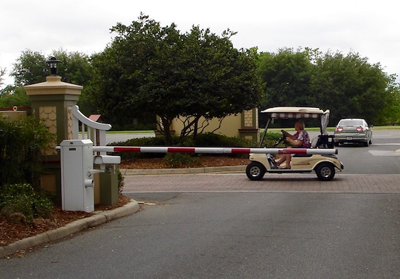Why Dealers and Consumers Would Be Better Off With a Dealer Association
One of the things that is truly puzzling when it comes to the last-mile delivery market, is why municipalities and carriers favor ecargo bikes as opposed to a light duty utility vehicles offered by a number of golf car-type (GCT) vehicle manufacturers.

Recently, city transportation officials in New York recommended that as a result of a trial run with ecargo bikes used for last-mile deliveries, the width of the cargo bay be increased from 37-inches to 48-inches. This modification would allow, other things equal, vehicles such as the Club Car Carryall 700 series and the Cushman Hauler Pro LSVs to compete in this market. The Club Car Current LSV is a bit wider (54-inches without mirrors), but offers a number of advantages—one being that there are a number of cargo modules available, from open to fully enclosed.
Products are great, but new markets are a no-show
Product upgrades and refinements continue bringing performance, convenience, styling, and comfort to new levels. This is especially true of LSV/PTVs and LDUs. For the most part, however, these improvements have been challenged into traditional markets. In two key markets these products have been no-shows, or close to it.
Two key markets need attention and promotion
The key markets are urban/suburban micromobility (USM) and last-mile delivery (LMD). While GCT vehicle OEMs have taken advantage of growth in the former, little has been accomplished with respect to the latter. The key components of the LMD market are the shippers, the carriers, and government officials responsible for transportation policy and oversight. None of these critical components come within the purview of the traditional CGT customer base. (This is not to say that GCT OEMs have not done business with companies that provide these services, but the vehicles involved are in the traditional utility or transporter capacities’).
In both situations, a case can be made for the formation of a dedicated dealer association to advocate and promote GCT vehicle market expansion. In fact, just such a dealer association has been recently launched and according to its founder, Brian Rott, is making good headway. The name of the organization is the Low-Speed Vehicle Dealer Association or the LSVDA. See details at LSVDA website: https://lsvda.com/
The power of local jurisdictions to regulate Emobility systems
It is a fact that local jurisdictions basically control urban/suburban transportation systems. A classic example of this is that in New York City the NYC DOT in advancing the use of wider cargo box (for ecargo bikes) and moving to four-wheel bikes, is bypassing Albany legislation, which is far more restrictive. NYC DOT is proposing a pilot program using the larger cargo bikes. In the previous pilot using a smaller version, city officials claimed that their data shows that more than 5 million packages were delivered by cargo bikes last year. According to the NYC DOT just two of the cargo e-bikes can replace one traditional delivery truck. The agency said that’s the equivalent of eliminating 30,872 passenger car miles traveled. In addition, in April, the city announced the use of “microhubs” where trucks unload packages to e-bikes for the last leg of deliveries.
New York City may be exceptional in creating and implementing a LMD system, but many cities are moving rapidly in the same direction. Clearly there should be a place for GCT utility vehicles. What’s needed to make this happen? First, GCT OEMs need to develop a marketing strategy to enter the market, and that means engaging shippers and carriers; that is, developing relationships with appropriate contact in these entities. Secondly, a vehicle for advocacy In a word, advocacy.
Advocacy through dealer representation

Given the power of local jurisdictions to guide and regulate transportation and general mobility systems, dealer and OEM representation at the local level is needed to spearhead the advocacy effort.
This is a critical factor because dealers need to be actively engaged in promoting their products in these markets. There are, for example, at least 8-10 GCT dealers within 150 miles of the New York City metropolitan area that could be mobilized through a representative association and effectively complement OEM marketing strategy.
Actively engaged means being in the public eye, such as showing up and presenting at public hearings, providing demonstrations of GCT vehicle capabilities, and showing safety features. Such efforts would require a dealer association such as the LSVDA to provide focus and program consistency.
Grass roots development pushes growth for on-road use of LSVs
LSVs surged in popularity during the COVID epidemic, and the market continues to grow from all indications. Just as the LMD market requires a corporate strategy and a dealer association to provide local area advocacy, so does successful development of the urban/suburban mobility (USM) market. In this case the dynamics a different from the LMD segment, where shippers and carriers are active and need to be brought on board.
The USM segment is growing in populous, but less congested areas compared to densely populated urban centers, such as New York City. LSVs have become a viable alternative to conventional automobiles for short distance driving, and as such, have become increasingly present on public roads. The result has been a plethora of local regulations around the country to deal with this phenomenon.
For the most part local regulations, and changes therein, as well as enforcement authority, remain at the local level. Things do get more complex when the short distance drive moves from one jurisdiction to another. Because of the essential “localness” and thus multiplicity of geographically small markets, dealers are ideally situated to have an impact on the regulatory environment. That impact, based on consistent advocacy across controlling jurisdictions, can be maximized through a dealers’ association, such as the LVSDA, cited above.
Action items: OEM strategy development and a dealers’ association
The combination of OEM marketing strategy focused on these key markets, plus an active grassroots advocacy organization are the essential keys to effectively broadening the market and significantly increasing sales. This may not be low-hanging fruit, but it’s not so far up the tree that it can’t be done.
_________________________
Small Vehicle Resource (SVR) publishes new market analysis
SVR announces new analysis of the small, task-orient vehicle (ST)V) market, with outstanding growth potential, and covering:
- Impact of new industry entrants;
- Segment analysis—LSV.PTV, light duty utility vehicles, and fleet;
- Trends from 2016, including the COVID disruption;
- Forecasts by segment and by electric vs. gas to 2030;
- Electrification of the off-road market;
- New market opportunities and benefits of a national dealers’ association
Contact the Author: Steve Metzger at smetzger@smallvehicleresource.com. Or check out our website at www.smallvehicleresource.com, where you will find an extensive database of vehicle models and can make side-by-side comparisons of vehicles based on a full set of specifications.


